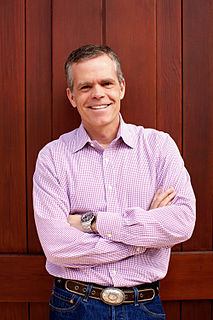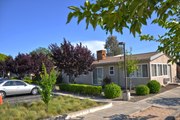
St. Helena is a city in Napa County, in California's Wine Country, part of the North Bay region of the San Francisco Bay Area. The population was 5,814 at the 2010 census.

Wine Country is the region of California, in the northern Bay Area, known worldwide as a premier wine-growing region. The region is famed for its wineries, its cuisine, Michelin star restaurants, boutique hotels, luxury resorts, historic architecture, and culture. Viticulture and wine-making have been practiced in the region since the Spanish missionaries from Mission San Francisco Solano established the first vineyards in 1812.

Robert Gerald Mondavi was an American winemaker. His technical and marketing strategies brought worldwide recognition for the wines of the Napa Valley in California. From an early period, Mondavi promoted labeling wines varietally rather than generically, which became the standard for New World wines. The Robert Mondavi Institute (RMI) for Wine and Food Science at the University of California, Davis opened in October 2008 in his honor.

The Culinary Institute of America (CIA) is an American private college and culinary school specializing in culinary, baking, and pastry arts education. The school's primary campus is located in Hyde Park, New York, with branch campuses in St. Helena and Napa, California; San Antonio, Texas; and Singapore. The college, which was the first to teach culinary arts in the United States, offers associate, bachelor's, and master's degrees, and has the largest staff of American Culinary Federation Certified Master Chefs. The CIA also offers continuing education for professionals in the hospitality industry as well as conferences and consulting services. The college additionally offers recreational classes for non-professionals. The college operates student-run restaurants on their four U.S. campuses.

Tyler Florence is a chef and television host of several Food Network shows. He graduated from the College of Culinary Arts at the Charleston, South Carolina, campus of Johnson & Wales University in 1991. He was later given an honorary doctorate from the university for his culinary success. He is the owner and executive chef of Wayfare Tavern in San Francisco.
Greystone or Graystone may refer to:

André Tchelistcheff was America's most influential post-Prohibition winemaker. Tchelistcheff is most notable for his contributions toward defining the style of California's best wines, especially Cabernet Sauvignon. Called the "dean of American winemakers", industry pioneers, such as Rev. John Staten of Field Stone Winery, Robert Mondavi, Louis Martini and Rob Davis of Jordan Vineyard & Winery, and Rick Sayre of Rodney Strong Wine Estates, considered him their mentor. Andre advised Warren Winiarski in launching Stag's Leap Wine Cellars which famously made the 1973 SLV Cabernet Sauvignon that was awarded the most points in the Paris Tasting, also known as the "Judgement of Paris", in 1976. Andre also assisted Ste. Michelle Wine Estates in launching the Anthology program at Conn Creek Winery in 1991.
Warren Winiarski is a Napa Valley winemaker and the founder and former proprietor of Stag's Leap Wine Cellars.

Heitz Wine Cellars is a California wine producer located within Napa Valley east of the town of St. Helena. An early modern era Napa Valley presence and pioneering exponent of French oak, the estate enjoys a historical renown with the success of its Martha's Vineyard Cabernet Sauvignon, and has also been described as a "master of Grignolino".

Copia: The American Center for Wine, Food & the Arts was a non-profit museum and educational center in downtown Napa, California, dedicated to wine, food and the arts of American culture. The center, planned and largely funded by vintners Robert and Margrit Mondavi, was open from 2001 to 2008. The 78,632-square-foot (7,305.2 m2) museum had galleries, two theaters, classrooms, a demonstration kitchen, a restaurant, a rare book library, and a 3.5-acre (1.4 ha) vegetable and herb garden; there it hosted wine and food tasting programs, exhibitions, films, and concerts. The main and permanent exhibition of the museum, "Forks in the Road", explained the origins of cooking through to modern advances. The museum's establishment benefited the city of Napa and the development and gentrification of its downtown.
Napa Valley AVA is an American Viticultural Area located in Napa County in California's Wine Country. Napa Valley is considered one of the premier wine regions in the world. Records of commercial wine production in the region date back to the nineteenth century, but premium wine production dates back only to the 1960s.

Margrit Biever Mondavi (August 2, 1925 – September 2, 2016) was a Swiss-born American businesswoman. She was Vice President of Cultural Affairs at Robert Mondavi Winery which she joined in 1967. Under her direction, Robert Mondavi Winery developed original cultural and culinary arts programs. In 1980, she married Robert Mondavi and worked with him in many of his philanthropic activities including the founding of the museum Copia. Margrit played a key role in securing the downtown Napa location for the center, which opened in November 2001. She died of stomach cancer on September 2, 2016.
The California Culinary Academy (CCA) was a for-profit school, and an affiliate of Le Cordon Bleu located in San Francisco, California. Danielle Carlisle established the school in 1977 to train chefs using the European education model. The original location on the corner of Fremont and Howard Street in the South of Market area of San Francisco, was located in the remodeled, top-floor, cafeteria in the Del Monte headquarters. The academy trained more than 15,000 people for restaurant careers through its 30-week baking and pastry chef program and 16-month culinary arts degree program. It was purchased by Career Education Corporation in 1999.

Christina Machamer is an American chef who won in the fourth season of Fox Network's reality cooking show Hell's Kitchen. She was awarded the position of "senior sous chef" at Gordon Ramsay's then-new restaurant at The London West Hollywood, where she earned a $250,000 yearly salary.

Silver Oak Cellars is a family-owned, California winery dedicated to producing only Cabernet Sauvignon. Silver Oak was established in 1972 by Ray Duncan and Justin Meyer. It is currently operated by Ray's sons David Duncan, who serves as the President and CEO, and his brother, Tim Duncan, who serves as Executive Vice President. Silver Oak has two wineries; one in Oakville in the Napa Valley and one in Healdsburg in the Alexander Valley. The Duncan Family also established Twomey Cellars in 1999, which has wineries in Calistoga and Healdsburg.

David Duncan is an American vintner and entrepreneur. The President and Chief Executive Officer of Duncan Oil, he is also the President and Chief Executive Officer of Silver Oak Cellars and Managing Partner of Twomey Cellars, successful wineries in northern California, operating in the Napa, Alexander and Russian River Valleys. He is the son of late Raymond Twomey Duncan, an oil and wine entrepreneur who co-founded Silver Oak in 1972 with Justin Meyer. Silver Oak is a family-run and owned business, and his brother Tim Duncan is Executive Vice President of the company. ColoradoBiz says that David Duncan is "as much a hands-on winery president as he can be", as president of a winery that has "reached cult status" for its Cabernet Sauvignon production.
The Culinary Institute of America at Copia is a branch campus of the private culinary college the Culinary Institute of America. The CIA at Copia, located at 500 1st Street next to the Oxbow Public Market in downtown Napa, California, opened its doors in autumn 2016.The CIA venue provides food- and wine-related courses to visitors. The CIA at Copia and The Culinary Institute of America at Greystone make up the school's California branch.

The Culinary Institute of America at Hyde Park is located in the town of Hyde Park, New York, between the Hudson River and U.S. Route 9. The Culinary Institute of America (CIA) campus offers associate and bachelor's degrees and certificate programs in culinary arts and baking and pastry arts. It is the school's primary and largest campus, with about 2,300 students.

The history of the Culinary Institute of America (CIA) began in 1946 in New Haven, Connecticut, where it was founded as a vocational institute for returning veterans of World War II. With a growing student body, the Culinary Institute purchased a former Jesuit novitiate in Hyde Park in 1970, which remains its central campus. The school began awarding associate degrees in 1971 and bachelor's degrees in 1993. The school opened its St. Helena campus in 1995, its Texas campus in 2008, its Singapore campus in 2010, and its Napa campus in 2016.


























